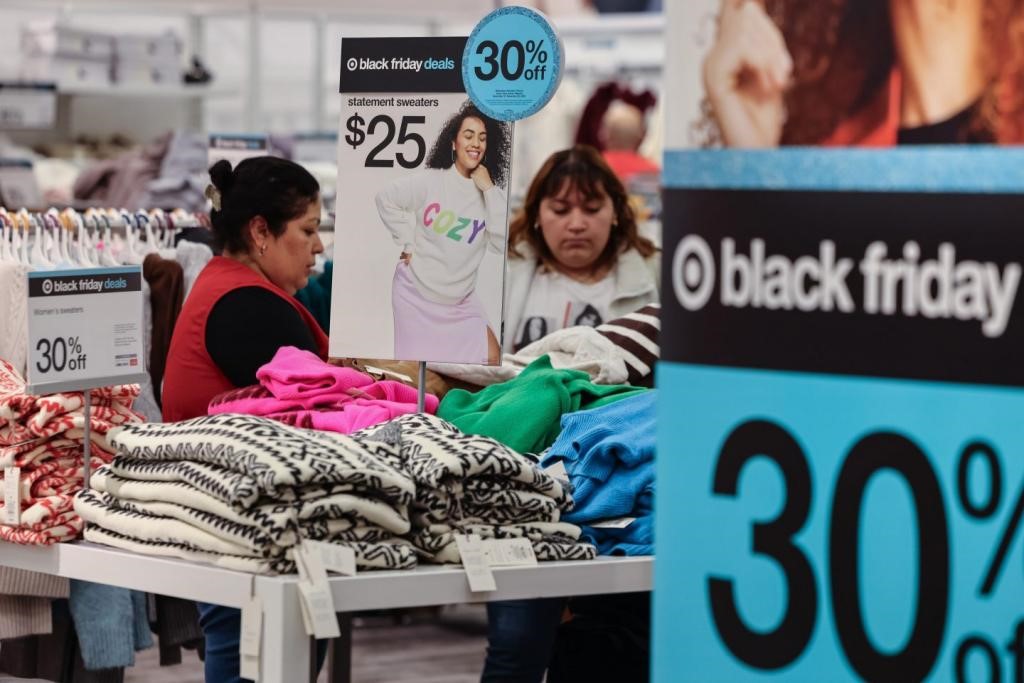
来自明尼苏达州的塔吉特(Target)正在继续采用其熟悉的自营品牌策略,该策略为公司创造了300亿美元年销售额。但现在,他开始向其他零售商投放其自营产品,没有走竞争对手的老路。
该连锁超市在周一宣布,计划在哈德逊湾公司(Hudson’s Bay Co.)的85家加拿大连锁超市丰富其Cat & Jack系列童装,将在该品牌1,400种商品中增加外套和鞋子。该品牌的商品大多数售价低于15美元。塔吉特表示,自从今年3月两家公司建立合作伙伴关系以来,该品牌在加拿大日益受欢迎,使哈德逊湾公司的购物篮系数增长了15%。
虽然塔吉特没有计划在美国推广其自营品牌,但扩张Cat & Jack品牌是该公司在可自由支配收入减少时赢得消费者的最新策略。今年2月,塔吉特推出了一个新低价品牌Dealworthy,出售10美元以下的家居用品。2023年,塔吉特的销售额下滑了1.7%,降至1,058亿美元。
塔吉特未能像竞争对手沃尔玛一样增长市场份额。虽然两家公司的策略有些趋同,但沃尔玛的销售额却在稳定增长。上周,沃尔玛推出了一个食品杂货自营品牌,3月,塔吉特模仿Amazon Prime和Walmart+,推出了付费回馈计划“Target Circle 360”。
零售商发展自营品牌,这并不意外。CivicScience在2023年9月的一份报告显示,约60%的购物者表示,他们至少会较为频繁的购买自营品牌商品。据市场调研公司Circana统计,2023年,自营品牌销售额增长6%,达到2,170亿美元。但专家表示,虽然零售商会相互借鉴,并参考消费者的意见上架自营品牌,但塔吉特却采取了一种更加不同寻常的做法。
打破惯例
市场营销公司Crew Marketing Partners的创始人兼CEO布雷登·道格拉斯对《财富》杂志表示,塔吉特在自有商店以外扩张自营品牌的做法并不受欢迎。
他说道:“这并不常见,因为其他大多数零售商不想帮助竞争对手增加收入。”
糟糕的经济环境意味着大卖场零售商为了吸引消费者,更有可能承担战略风险。对于塔吉特而言,此举是合理的选择。道格拉斯表示:塔吉特有可靠的供应链,可以灵活地进行扩张,但塔吉特的业务几乎集中在美国,这成为一个制约因素。2013年,塔吉特从哈德逊湾公司收购了200多家Zellers(一家倒闭的连锁零售商)的租约,进军加拿大市场。由于塔吉特的快速扩张,该笔收购预计到2021年才能实现盈利。但塔吉特在不到两年后就关闭了所有加拿大连锁店。扩大在哈德逊湾公司销售的自营品牌种类,让塔吉特可以重新在北方邻国进行艰难的尝试。
道格拉斯说道:“市场上仍有很大需求。我很高兴看到他们愿意重新进行尝试。”
经过估算的风险
北卡罗来纳大学教堂山分校(University of North Carolina at Chapel Hill)克南-弗拉格勒商学院(Kenan-Flagler School of Business)的市场营销教授卡特琳·吉耶朗斯表示,虽然塔吉特采用了非同寻常的自营品牌策略,这并不意味着这种策略没被使用过。塔吉特也销售竞争对手的自营品牌商品,包括连锁药店博姿(Boots)的护肤品牌NO7。吉耶朗斯曾经见过全国食品杂货连锁店采取类似措施,成功将注重健康的自营品牌投放到小型地区性商店。
吉耶朗斯同意道格拉斯的观点,认为竞争对手在彼此的商店内投放自营品牌商品的情况并不常见。但她表示,在新的地区拓展自营品牌,或者吸引特定人群,是一种低成本的增加曝光度的方式,因为大规模购买和分销自营品牌,往往具有节约成本的优势。
她说道:“你需要有一定的信誉;还要有专业技能和知识。这并不容易实现。”
吉耶朗斯表示,从2008年至2012年,向其他零售商拓展自营品牌的做法变得日益常见,而且这种趋势往往会出现在经济动荡时期。自营品牌不仅能在经济衰退时期提供一种有效的销售策略,即使在经济衰退结束之后,对自营品牌的兴趣通常也能持续多年。福布斯根据尼尔森(Nielsen)和信息资源公司(Information Resources, Inc.)的数据称,各零售商的自营品牌从2008年至2022年创造了约350亿美元收入。
由于通胀依旧顽固,消费者信心低于疫情之前的水平,因此吉耶朗斯预计会有更多公司采取与塔吉特类似的甚至更冒险的举措,充分利用自营品牌。
她说道:“这时候人们就会更愿意探索和考虑价格略低的商品。这是恰当的机会窗口。”(财富中文网)
翻译:刘进龙
审校:汪皓
来自明尼苏达州的塔吉特(Target)正在继续采用其熟悉的自营品牌策略,该策略为公司创造了300亿美元年销售额。但现在,他开始向其他零售商投放其自营产品,没有走竞争对手的老路。
该连锁超市在周一宣布,计划在哈德逊湾公司(Hudson’s Bay Co.)的85家加拿大连锁超市丰富其Cat & Jack系列童装,将在该品牌1,400种商品中增加外套和鞋子。该品牌的商品大多数售价低于15美元。塔吉特表示,自从今年3月两家公司建立合作伙伴关系以来,该品牌在加拿大日益受欢迎,使哈德逊湾公司的购物篮系数增长了15%。
虽然塔吉特没有计划在美国推广其自营品牌,但扩张Cat & Jack品牌是该公司在可自由支配收入减少时赢得消费者的最新策略。今年2月,塔吉特推出了一个新低价品牌Dealworthy,出售10美元以下的家居用品。2023年,塔吉特的销售额下滑了1.7%,降至1,058亿美元。
塔吉特未能像竞争对手沃尔玛一样增长市场份额。虽然两家公司的策略有些趋同,但沃尔玛的销售额却在稳定增长。上周,沃尔玛推出了一个食品杂货自营品牌,3月,塔吉特模仿Amazon Prime和Walmart+,推出了付费回馈计划“Target Circle 360”。
零售商发展自营品牌,这并不意外。CivicScience在2023年9月的一份报告显示,约60%的购物者表示,他们至少会较为频繁的购买自营品牌商品。据市场调研公司Circana统计,2023年,自营品牌销售额增长6%,达到2,170亿美元。但专家表示,虽然零售商会相互借鉴,并参考消费者的意见上架自营品牌,但塔吉特却采取了一种更加不同寻常的做法。
打破惯例
市场营销公司Crew Marketing Partners的创始人兼CEO布雷登·道格拉斯对《财富》杂志表示,塔吉特在自有商店以外扩张自营品牌的做法并不受欢迎。
他说道:“这并不常见,因为其他大多数零售商不想帮助竞争对手增加收入。”
糟糕的经济环境意味着大卖场零售商为了吸引消费者,更有可能承担战略风险。对于塔吉特而言,此举是合理的选择。道格拉斯表示:塔吉特有可靠的供应链,可以灵活地进行扩张,但塔吉特的业务几乎集中在美国,这成为一个制约因素。2013年,塔吉特从哈德逊湾公司收购了200多家Zellers(一家倒闭的连锁零售商)的租约,进军加拿大市场。由于塔吉特的快速扩张,该笔收购预计到2021年才能实现盈利。但塔吉特在不到两年后就关闭了所有加拿大连锁店。扩大在哈德逊湾公司销售的自营品牌种类,让塔吉特可以重新在北方邻国进行艰难的尝试。
道格拉斯说道:“市场上仍有很大需求。我很高兴看到他们愿意重新进行尝试。”
经过估算的风险
北卡罗来纳大学教堂山分校(University of North Carolina at Chapel Hill)克南-弗拉格勒商学院(Kenan-Flagler School of Business)的市场营销教授卡特琳·吉耶朗斯表示,虽然塔吉特采用了非同寻常的自营品牌策略,这并不意味着这种策略没被使用过。塔吉特也销售竞争对手的自营品牌商品,包括连锁药店博姿(Boots)的护肤品牌NO7。吉耶朗斯曾经见过全国食品杂货连锁店采取类似措施,成功将注重健康的自营品牌投放到小型地区性商店。
吉耶朗斯同意道格拉斯的观点,认为竞争对手在彼此的商店内投放自营品牌商品的情况并不常见。但她表示,在新的地区拓展自营品牌,或者吸引特定人群,是一种低成本的增加曝光度的方式,因为大规模购买和分销自营品牌,往往具有节约成本的优势。
她说道:“你需要有一定的信誉;还要有专业技能和知识。这并不容易实现。”
吉耶朗斯表示,从2008年至2012年,向其他零售商拓展自营品牌的做法变得日益常见,而且这种趋势往往会出现在经济动荡时期。自营品牌不仅能在经济衰退时期提供一种有效的销售策略,即使在经济衰退结束之后,对自营品牌的兴趣通常也能持续多年。福布斯根据尼尔森(Nielsen)和信息资源公司(Information Resources, Inc.)的数据称,各零售商的自营品牌从2008年至2022年创造了约350亿美元收入。
由于通胀依旧顽固,消费者信心低于疫情之前的水平,因此吉耶朗斯预计会有更多公司采取与塔吉特类似的甚至更冒险的举措,充分利用自营品牌。
她说道:“这时候人们就会更愿意探索和考虑价格略低的商品。这是恰当的机会窗口。”(财富中文网)
翻译:刘进龙
审校:汪皓
Target is continuing to lean into its familiar strategy of private-label brands that have brought the Minnesota-based company $30 billion in annual sales—but now it’s veering from the path of competitors by putting its products in other retailers.
The big-box chain announced on Monday plans to expand its Cat & Jack children’s clothing line across 85 Hudson’s Bay Co. Canadian department stores, adding outerwear and shoes to the brand’s 1,400 items, most of which are under $15. Since the partnership launched in March, the brand has been incredibly popular in Canada, Target reported, resulting in a 15% increase in basket size at Hudson’s Bay.
Target has no plans to replicate its own-brand expansion in the U.S., but its Cat & Jack expansion is the latest of the company’s tactics to win over consumers in times of slashed discretionary spending. In February, the company launched a new “dealworthy” budget brand of under-$10 home goods. That’s after 2023 saw a 1.7% drop in sales to $105.8 billion.
Target has failed to make the same inroads as rival Walmart, where sales are steadily growing, though their strategies have converged. Last week, Walmart launched a store-brand grocery line, and in March, Target launched its paid reward program Target Circle 360, parroting Amazon Prime and Walmart+.
It should be no surprise that retailers are growing their private-label brands. About 60% of shoppers say they buy private labels at least somewhat frequently, per a September 2023 CivicScience report. And according to market research firm Circana, sales of own brands grew 6% in 2023 to $217 billion. But while retailers are taking cues from each other and consumers to line their shelves with own-brand items, Target is taking a more unconventional route, experts say.
Defying convention
Braden Douglas, founder and CEO of marketing agency Crew Marketing Partners, told Fortune that Target’s play to expand its private brands beyond its own stores isn’t a popular gambit.
“It’s not very common because most other retailers don’t want to help another competitor increase revenue,” he said.
The tough economic climate means that big-box retailers are more likely to take strategic risks to attract consumers. For Target, the move makes sense, Douglas argued: Target has a solid supply chain that allows it to be nimble and expand, but is limited by its own geography that’s almost exclusively in the U.S. Target made its debut in Canada in 2013, purchasing the leases of over 200 Zellers, a failed retail chain, from Hudson’s Bay. Because of Target’s rapid expansion, the venture wasn’t expected to be profitable until 2021, and the company pulled the plug on all of its Canadian chains less than two years later. Expanding offerings for Hudson’s Bay could offer Target a do-over of its rocky experiment up north.
“There’s still great demand from that,” Douglas said. “I like that they’re [going to] dip their toe back into the water.”
Calculated risk
While Target’s private-label strategy is uncommon, that doesn’t mean it’s unheard of, argued Katrijn Gielens, professor of marketing at University of North Carolina at Chapel Hill’s Kenan-Flagler School of Business. Even Target carries products from competitors’ private-label brands, including No7, the skincare line from pharmacy chain Boots. Gielens has seen similar moves from national grocery chains successfully putting health-conscious private-label brands in smaller, regional stores.
Gielens agreed with Douglas that competitors will not frequently put their own-brand products in each others’ stores. But she added that expanding private brands to new geographies or to appeal to specific demographics is a cheap way to build exposure, because buying and distributing private brands on a larger scale often has cost-saving advantages.
“You need a certain reputation; you need to have certain expertise and knowledge,” she said. “It’s not easy to pull off.”
The practice of expanding private-label brands beyond their originating retailer grew more common from 2008 to 2012, and the trend tends to emerge in times of economic unease, Gielens said. Not only do private brands offer an effective sales strategy during times of recession, but interest in those brands is usually sustained in the years that follow. From 2008 to 2022, private brands across retailers made an estimated $35 billion, Forbes reported, using data from Nielsen and Information Resources, Inc.
As inflation remains stubborn and consumer confidence still lower than it was pre-pandemic, Gielens expects to see companies making moves similar to Target’s, even riskier ones, to take advantage of private-brand favorability.
“This is when people are more open to explore and to also consider things that come with a slightly lower price point,” she said. “It’s the right window of opportunity.”






